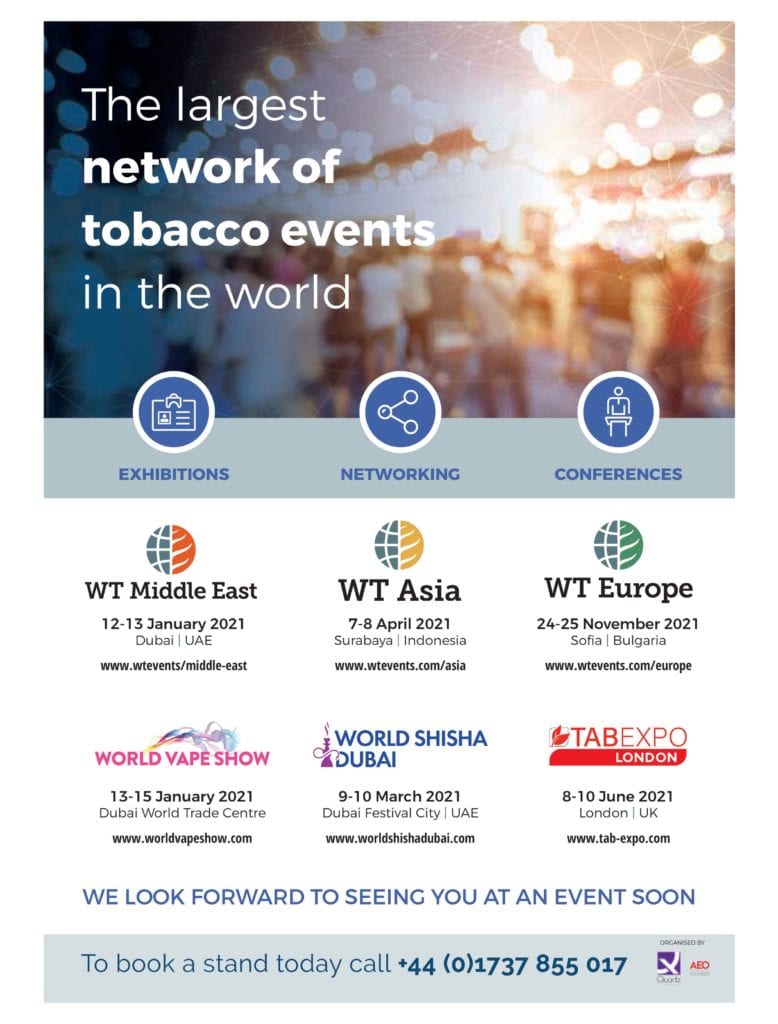
This year’s Global Tobacco and Nicotine Forum (GTNF) focused on innovation and sustainability in the ENDS industry.
By Vapor Voice staff
The Global Tobacco and Nicotine Forum (GTNF) has been one of the most insightful conferences over the past decade, especially in its embracing of electronic nicotine-delivery systems (ENDS) and their potential for harm reduction. During this year’s event, held in London from Sept. 21-23, speakers were challenged to focus their insights on this year’s theme: Continuing Change: Innovation & Sustainability. Below, we have provided session overviews of the many keynote speeches and panel discussions that centered on ENDS products. Next year’s GTNF will be held in Seoul, Korea on Sept. 20-22.
GTNF Fireside Chat with Todd Cecil, FDA
The U.S. FDA insists its banning of all flavored e-liquids other than tobacco is not a de facto ban on the products.
By VV staff
When the U.S. Food and Drug Administration began issuing marketing denial orders (MDOs) for vapor products, the industry was understandably shocked. Many companies that had submitted timely premarket tobacco product applications by Sept. 9, 2020, had expected to first receive a deficiency letter and not immediately an order to remove their products from the market. Some MDO recipients complained the agency had “moved the goalposts” by suddenly requiring studies that it had previously said were not required.

At least four companies have filed lawsuits over their MDOs. All are accusing the agency of making “arbitrary” decisions and not reviewing the submitted data according to the statutes. In a “fireside chat” between Joe Murillo, chief regulatory officer for Juul Labs, and Todd Cecil, deputy director of the Office of Science for the FDA’s Center for Tobacco Products, during the recent GTNF in London, Cecil acknowledged the missing data that caused the flurry of MDOs is not required by the statutes that regulate tobacco products.
When asked what the “level of expectation” the FDA had in deciding whether to issue a deficiency letter or an MDO after a premarket tobacco product application (PMTA) was moved into scientific review, Cecil said that the agency followed “a randomized approach” to choose the applications the FDA would work on.
“The randomized approach identified a number of manufacturers’ products that went into this scientific review, and we … evaluated them from top to bottom,” he said. Cecil noted the agency began to see in some applications that “tended to have problems or missing materials that we needed in terms of benefits [of flavors]; that we learned we have to have that benefit piece … that evaluation that we spent several months working on taught us what we had to look for to be able to [conduct] a full scientific review.”
Cecil said that the agency just figured “if we know going right in that there are pieces missing, why will they go through a deficiency process and with a very short turnaround expecting to get back a full study that wasn’t completed previously?” So, instead of issuing a deficiency letter as required by statute, the FDA just handed out MDOs because the agency knew that it would take a company a significant amount of time and expense to conduct the new required longitudinal and cohort studies. Cecil was then asked why the agency filed the applications in the first place.
“We had to make a determinant how can we streamline this evaluation and determine those products that have at least the bare minimum for us to do a real and complete evaluation,” Cecil said. “This evaluation is not a standard. It is not a de facto standard or anything else. This is information that we need to see, but it’s not a requirement. An RTF [refuse to file] are those things that are required by the statute. And these studies are not necessarily required by the statute.”
The FDA has also been facing an unprecedented amount of scrutiny on its handling of the regulation of electronic nicotine-delivery system (ENDS) products and the PMTA process. Numerous health groups, anti-nicotine groups, states attorneys general and even members of Congress have criticized the FDA and demanded action. When asked if the FDA’s actions were influenced by these groups, Cecil said the agency focuses on science.
“We’re science-based,” he said. “We need look at what is presented to us in the application and in the laboratory. That is what we’re most focused on. If there is new data out there and that new data is brought to our attention through one of these [groups], then that’s fine. We would be happy to get those up and understand the bigger picture, all of the data … We need to evaluate those … scientifically or make a determination based upon that science.”
Only 100,000–200,000 products remain under FDA review. Of the 6.7 million submitted PMTAs, all others have received either a refuse-to-accept, an RTF or an MDO response. Cecil denied the agency was making a “categorical policy decision as opposed to an application-by-application decision” about flavored products. “We are stating that we understand that there is a significant youth initiation risk that comes from flavored ENDS products,” he said. “We are, in fact, reviewing all of those, and what we have found as we’ve done our reviews is that none of the literature is sufficient to demonstrate that there is not a youth initiation risk for individual flavors.
“We see that tobacco has a lower initiation risk. We see that menthol has some issues with it, and we are going to be evaluating that as we go forward. However, all of the data points to the flavored products as having significant youth initiation concerns. So what we’re looking for is an adequate indication that there’s a benefit on the other side of the equation. This is not a decision that we aren’t going to accept flavored products. Absolutely opposite. We need to ensure that there is concrete and robust data that demonstrates that there is an existing user benefit for those products.”
Cecil declined to say when more MDOs would be issued or when the agency would rule on major products, such as Juul, NJOY, blu and Vuse. “We continue to work diligently,” is all he would say. “There are a number of products that are well along. But no, I can’t tell you how many are those ones, but there are some that we’re hoping to move forward in the short term.”
The FDA’s recent action against flavored e-liquids does not mean that the FDA will never approve a flavored e-liquid, according to Cecil. He said that the rejected applications just lacked the required information that those products met the agency’s “appropriate for the protection of public health” standard. “You are welcome to reapply once you have addressed the issues that we provided to you,” he said. “And we will reevaluate that at a future date.”
GTNF Panel: The Fork in the Road: What is Next for Tobacco and Nicotine
Regulators must remember the vaping industry began with hobbyists and enthusiasts who built their own devices.
By VV staff
The vaping industry faces many challenges. The road to a viable future for these products must pass through sensible regulations based on science. In the current environment, unfortunately, this will be challenging, according to speakers on the GTNF plenary panel The Fork in the Road: What is Next for Tobacco and Nicotine. Misperceptions surrounding nicotine and vaping products, the panelists agreed, are furthered by the mass media’s “wonton disregard” for the science behind the tobacco harm reduction potential of electronic nicotine-delivery systems (ENDS).

One speaker noted that in addition to many countries banning or erecting insurmountable barriers to vaping products, well-funded anti-nicotine activists are attacking the people who are bringing reduced-risk products to adult combustible cigarette smokers trying to quit smoking. These groups are opposed to the tobacco harm reduction that science and innovation can bring.
All of these activities together only serve to enhance the vaping industry’s problem: the massive public misperception that vaping is as deadly as smoking cigarettes. The fact that a significant number of physicians mistakenly belief that nicotine, rather than combustion, is responsible for smoking-related illness, bodes ill for the perceptions among the general population. “If physicians believe this, imagine the views of the average smoker in Kenya or Chicago, Illinois, or in Australia,” one speaker said.
While anti-nicotine activists have done their share to misperceptions, the vaping industry too is partly to blame, according to one panelist. The ENDS industry can do a lot more than feel helpless or complain, this speaker noted. Innovation in harm reduction cannot occur without the vaping industry’s support. That means responsible marketing, combating illicit trade, limiting youth access and making sure that the ENDS industry is doing what it can to prevent underage use.
Panelists also expressed concern about the direction of the vapor market in the wake of the U.S. Food and Drug Administration’s marketing denial orders (MDOs), with some describing a “Wild West” scenario. After receiving MDOs, some companies have turned to synthetic nicotine because that product currently is outside of the agency’s jurisdiction. A panelist said that the FDA’s “scorched earth” approach to flavored products is only creating bigger problems in the market, adding that if a market isn’t regulated, there is still going to be an unregulated illicit market that has the potential to be more deadly than that for combustible tobacco.
“Nobody wants kids to take up the products … it’s a very significant responsibility that we in industry be there to be the stewards of that concept in generating science and evidence,” a panelist said. “We should all be proud of the good science that is being generated … that is our responsibility: to generate and publish and participate in the scientific debate and pursue reasonable regulation. What is reasonable? I don’t know. It’s not going to be nothing. We all have to get over it and figure out what is the right way forward so we can go back to helping the consumer and making sure we’re only serving smokers who are looking for alternatives to combustibles.”
GTNF Panel: Consumers: The Key Stakeholders
Harm reduction should empower individuals to make their own choices about what products they consume.
By VV staff
For many people, the threats they face in day-to-day life are far more immediate than their long-term health. The mission of harm reduction should be to empower people to make their own choices about what products they consume and their own health decisions, even if those decisions don’t align with what public health experts would say is optimal. This was the general focus during a plenary panel discussion at the GTNF called Consumers: The Key Stakeholders.

Most of the session centered consumers standing up and advocating for the industry, the global attacks on flavored e-liquids and growing threats from the World Health Organization (WHO), which remains suspicious of tobacco harm reduction. Panelists agreed that while some consumers prefer to remain on the sidelines, many others are willing to get organized and campaign for tobacco harm reduction and the vaping industry. “The consumer voice is very powerful,” a panelist said.
A major concern for the vaping industry is the concerted campaign against flavors. Flavors, according to one panelist, are used to by the industry’s enemies to redirect the conversation toward children. “They’ll say vaping flavors attracts children, and then they get us to play in their playground,” he said. “It’s very different. You [consumers] have got to keep asserting that adults use flavors.”
The WHO is a threat no matter what, the panel agreed. The global health body is now even talking about redefining smoke to include anything that’s heated and emits a vapor. “This means that any customizability of a product will be restricted and have limits on it, which basically means all the vape products will be the same,” explained one panelist. “These [recommendations] have to be resisted. The WHO doesn’t make laws, but it’s very influential, and these things can’t just be waved away.”
The scientific studies the WHO uses to justify its negative view toward next-generation products as tools for harm reduction are “fantasy and cherry-picked” studies, according to another speaker. “The people who are against harm reduction will never sleep. They’re always working, and they’re highly funded,” a panelist said. “[Consumers] have to stay alert, and they have to stay organized because, at the end of the day, there are more consumers than there are activists against harm reduction, and we’ll vote. So, consumers really have a big role to play.”
Consumers are the key stakeholders. However, when talking about consumers, regulators must acknowledge that not every smoker is the same, according to the panel. Many smokers don’t want to quit combustibles. “The important thing is to understand why and respect their choice,” a panelist said.
One speaker said that the industry also needs more responsible vape reviewers on YouTube because the current ones “are absolutely appalling.” The speaker urged consumers to make their voices heard in politics. “You’ve got to have somehow to get ahold of your Parliamentarians or your politicians in your country and get them to campaign on your behalf because there are many, many consumers, but you haven’t got great voice in government, and that’s what you really need to try and get,” he said.
At the end of the session, an audience member asked the panel if it could see a situation where consumers would sue regulators over counterproductive rules, such as flavor bans. “I have mentioned the fact that it would be interesting if someone could do a test case, but I don’t know whether that someone could come from the consumer side and sue [over regulatory action],” the panelist said. “It’s also expensive, and someone will end up having to pay if you lose.”
GTNF Panel: Science Driving Innovation
The nicotine delivery of products and being conscience of the environment are key points in innovation.
By VV staff
Regulators globally are becoming more understanding of what they expect next-generation tobacco products to accomplish. Regulators want manufacturers to demonstrate, on a product-specific basis, whether the vaping products are a benefit to combustible cigarette smokers. More importantly, manufacturers must ensure that vulnerable populations such as youth are not using these products.

During the lunchtime GTNF panel “Science Driving Innovation,” one speaker also mentioned that manufacturers must be more conscious about the environmental impacts of vaping products too. The environment is a big issue in the minds of governments, regulators and society as a whole. The panelists agreed that vaping manufacturers should produce products that are environmentally sustainable.
“Think about all the batteries that go to waste every time an e-cigarette is disposed of. What are we doing as an industry to address the fundamental questions that society and regulators are concerned about?” a panelist asked. “We need to start thinking about what views of science we need to really put our investments in [and start] focusing on going into the future.”
Another major industry concern that should be addressed through innovation is youth initiation. One panelist said this topic should be a primary focus of scientific efforts relating to vaping products. Reduced-risk products must exist for adult smokers, so it’s imperative that the industry proactively addresses the underage use issue. “If we don’t, others will try to do it for us, and then collectively, we will all compromise the potential that [we are focusing on during the conference] today,” one panelist said. “It’s a critical balance. It’s important that we offer adult smokers an alternative, and we can also combat underage use. We can do both, and we must because there’s too much at stake if we don’t.”
Another speaker discussed her company’s global retailer compliance monitoring program. The company sends thousands of “mystery shoppers” into U.S. retail outlets that sell its vaping products and collects data around whether the retailers are abiding by federal age verification laws and/or other local policies.
“What we found is that retailers need help. There’s a lot going on in this world. We help them by providing information on how they’re performing, education and training, and we can also assist in changing their existing point-of-sale technology,” she said. “It can actually prompt the clerks to check ID when they’re selling an interesting new product. And it alleviates the mental burden on their end.”
Another concern for the industry that can be addressed through innovation is improving nicotine delivery and satisfaction. That satisfaction delivered by products today is not enough to sustain the large number of people we want to see switching from cigarettes to electronic nicotine-delivery systems.
“To achieve meaningful harm reduction, we need these products to appeal to and be affordable to most adult cigarette smokers. Which means those consumers would need to like the product and be able to afford the product,” a speaker said. “They need to be able to trust these products, and it requires a significant investment in innovation if you want to do it properly.”
GTNF Plenary Panel: Innovation as the Path to Progress
The more freedom the industry has to innovate, the more likely smokers are to transition away from combustibles.
By VV staff
Innovation is grounded in regulation. Regulators can either embrace innovation as a tool to support harm reduction, or they can regulate them to the point that any innovation is impossible to bring to market. During the GTNF panel Innovation as the Path to Progress, one speaker explained that the U.S. Tobacco Control Act was written with the goal that the state of public health will change over time. The idea is that as smokers quit and product standards are implemented, many may migrate to products lower on the risk continuum. As a result, as the state of public health changes, the products that the U.S. Food and Drug Administration determines to be appropriate for the protection of the public health (APPH) will also change.

“If you think about the significance of the innovation of the e-cigarette, today we have major companies that are in the tobacco space talking about eliminating combustion altogether,” a panelist noted. “We have companies giving up their entire combustible segments, and that would not have happened, in my opinion, had it not been for the innovators.”
Making innovative progress in the vapor industry is measured by transitioning adult smokers to noncombustible products, according to the panel. However, there are many avenues to accomplish this goal as well as numerous obstacles. One speaker offered the audience three focus areas that he described as the pillars of innovation. The first pillar is product innovation. “If the product is not satisfying, people are not going to switch,” the speaker said. “In order to get there, we will need a very disciplined, science-based approach in understanding some of the questions underlying satisfaction. As we think about innovation and product innovation, it’s important for smokers to have a range of products to choose from.”
The second pillar is scientific innovation. There must be a comprehensive assessment of science to demonstrate that a product is APPH, and while all novel products tobacco products must be held to this high standard, it is rigorous and takes time. There are innovations in scientific methodologies that must be made, the speaker explained.
The speaker cited dissolution methods to understand nicotine release profiles and computation of toxicology as examples of tools that can help accelerate this pathway for getting products in the market. “Along with that, I think that regulators have an opportunity to create some innovative processes,” the speaker said. “For example, establishing product standards that will hopefully help these products be reviewed in an expedited manner, and most importantly, get them in the hands of consumers.”
The third pillar is communication. The industry needs to make clear the benefit to smokers by switching to noncombustible products. The industry needs to address the misperceptions surrounding nicotine and the wrong assumption nicotine causes cancer. “This clouds the decision-making process of adult smokers,” the speaker said. “As manufacturers in the U.S., we have to seek FDA authorization before we can communicate a modified-risk or modified-exposure order. That, too, is important but time-consuming and resource intensive. This is a responsibility for everybody to explore innovative communication approaches that can address these misperceptions.”
Another area ripe for innovation in the electronic nicotine-delivery system industry is environmental sustainability. For example, e-cigarette batteries contain heavy metals. The industry must innovate battery technology that will reduce their products’ environmental impact. Responsible disposal of any product is important. Regulation can also impact environmental issues. In the U.K., for example, requiring 10 mL bottles instead of larger bottles creates more waste.
Finally, synthetic nicotine also offers innovative advancements for next-generation products. “I think that when we talk about moving away from combustion, that is one thing, but when we talk about moving away from tobacco—in other words, giving consumers a truly tobacco-free option—that’s where science comes in,” a panelist explained. “The promise that is involved with synthetic nicotine is significant. They need to research it closely and recognize that it does provide certain benefits that perhaps the tobacco-derived nicotine does not.”
GTNF Keynote: Frank Han
The leader of FEELM said that exciting innovations are happening every day in the vaping industry.
By VV staff
During a keynote address for GTNF, Frank Han, senior vice president of Shenzhen SMOORE Technology Co. and CEO of its FEELM business division, said that there are exciting innovations—big and small—happening every day in the vaping industry. Vaping products using FEELM atomization technology have now reached millions of users in more than 50 countries.

“Vaporization technology is still just at the beginning; we could welcome the opportunity for innovation to create a better life together … Basic Science Innovation has been the cornerstone for sustainable growth; it is the science of atomization that we need to build as the foundation supporting the industry,” he said, speaking through an interpreter. “As a firm believer of innovation, SMOORE has integrated disciplines like engineering thermodynamics and biomedical sciences into our atomization research.”
SMOORE has been actively learning to understand and assess the long-term health effects of vaping, according to Han. The company currently has seven research centers between the U.S. and China, “bringing in global talents” from different backgrounds. In addition to in-house R&D resources and efforts, SMOORE is also focused on partnering with leading universities to transform the company’s scientific discoveries into applied technologies. “The way vape products are manufactured is also constantly evolving; more effectively and definitely more environmentally friendly,” said Han.
SMOORE had begun operations using the first fully automated pod production line in the world. Each new manufacturing (single) line can produce 7,200 standard vaporizers per hour, double the previous generation’s output. “We have been working with business partners to improve sustainable practices in all stages of product development, especially manufacturing with the common goal of reducing carbon footprint,” said Han.
SMOORE is currently evaluating the underlying technology of atomization for its potential applications in other fields. “With one direction of our R&D focus on the atomization application in healthcare, I am proud that SMOORE has made progress on the research of atomized medication, along with partners from different sectors,” Han said. “The initial results are all positive. We are hoping in the near future, more and more people might be able to inhale medicines or even vaccines with atomization devices.”
Looking ahead at the vaping industry overall, Han said that policymakers and NGOs must be inclusive. Regulation has been a heated topic recently in both the U.S. and China, and while institutional innovations to promote healthy industry development and more balanced regulations are needed, regulators must also embrace vaping as a strategy to improve public health while safeguarding against youth initiation, he said.
“The global media must also be inclusive. We must value the media that report from an unbiased perspective, involving more people in the public dialogue on vaping, discussing the pros and cons and discovering the truth,” said Han. “I’d like to share an old Chinese saying here: ‘Though the road ahead is dangerous and difficult, we can only achieve our goals with constant efforts.’ We must press ahead with a sense of perseverance to expect a better future.”
Amanda Wheeler: NO SURRENDER
Her dreams and business crushed by a marketing denial order, Amanda Wheeler vows to continue the fight for vaping.
By Timothy S. Donahue
Amanda Wheeler got involved in the vapor business after a personal tragedy. Despite a cancer diagnosis at age 19, she was unable to quit smoking for another 11 years—until she discovered vapor products. Eager to share her success with others, Wheeler and her husband, Jourdan, opened JVapes, an e-liquid manufacturer and retail store in Prescott, Arizona, USA, in 2012.

The business was successful, quickly expanding to multiple locations across three states. Wheeler was helping her customers quit smoking combustibles and became increasingly involved in advocacy. She joined several support organizations, including Arizona Smoke Free Business Alliance, Vaping Advocates of Oklahoma, Rocky Mountain Smoke Free Alliance, Smoke Free Alternatives Trade Association, American E-Liquid Manufacturing Standards Association and Vapor Technology Association.
In October of 2020, Wheeler and fellow business owner Char Owen created the American Vapor Manufacturers Association (AVM) to help small businesses navigate the U.S. Food and Drug Administration’s onerous premarket tobacco product application (PMTA) submission process. The organization also engaged in federal lobbying and sought to provide reduced-cost scientific testing and expert regulatory compliance advice to members preparing PMTAs.
Wheeler and the AVM assisted 230 e-liquid manufacturers that submitted PMTAs for more than 1.7 million products following a plan she developed with Azim Chowdhury, a partner with the law firm Keller and Heckman and a regulatory and public policy attorney with a focus on vapor, nicotine and tobacco product regulation.
The deadline for submitting PMTAs to the FDA was Sept. 9, 2020. Wheeler submitted timely applications and was allowed to keep her products on the market for up to one year while the FDA reviewed her submissions. The agency’s deadline to decide on all the applications was Sept. 9, 2021. When Wheeler’s application was accepted, she felt confident that her business could survive and that the industry had a future.
As the deadline approached, however, Wheeler became anxious. The FDA was slow to release information before the deadline. Then, on Sept. 9, 2021, Wheeler received a marketing denial order (MDO). The regulatory agency appeared determined to put the small company she and her husband had built, along with the industry she passionately defended, out of business.
That day, the FDA issued MDOs to more than 130 companies, requiring them to pull an estimated 946,000 products from the market. The bloodbath continued in the following weeks. At press time, the FDA had issued 323 MDOs accounting for more than 1,167,000 flavored electronic nicotine-delivery systems (ENDS). As of Sept. 28, not a single ENDS had been approved.
That’s how Wheeler found herself on the global stage, sharing her story with some of the largest players in the nicotine industry at the recent GTNF conference in London.
“[The] FDA knew that they didn’t have the time or the resources to give our products fair consideration, but instead of asking for help, they let the 9/9 deadline pass and left the more than 500 companies subject to their decision in an unstable and probably untenable position,” Wheeler explained. “The FDA’s arbitrary ruling effectively criminalizes thousands of long-standing businesses in communities all across the country. Those entrepreneurs now have to junk their inventory, fire their employees, stiff their investors, and defer their dreams.”
Wheeler said she was standing up for the “little guy”—the thousands of small business owners who manufacture, distribute and retail open system products in vape shops all over the United States. She explained that her business and other AVM members made every attempt within their means to comply with the FDA regulations. It was an expensive process. It was also a system designed for small businesses to fail from the very beginning, she said.
“My company personally submitted several hundred thousand pages of documents to the FDA in an attempt to comply with this one premarket tobacco application standard. The [FDA’s] decision doesn’t just make a mockery of that earnest work. It also makes the more than 10 million Americans who made the switch to vapor products—in our vape shops, with our liquids—into outlaws, too,” said Wheeler. “Their freedom as Americans no longer includes the right to use a product with none of the well-established, deadly effects of those other substances, and which has undoubtedly saved the lives of countless former smokers.”
Wheeler said the FDA, in an act of “regulatory arson,” was creating a tobacco-led monopoly over the vaping industry, as only the companies with the deepest pockets stand a chance to survive the agency’s cumbersome PMTA process.
She also focused on what she perceived to be one of the biggest challenges facing the industry today: misinformation. “There is one other group I want to address with my time here. It’s the activists and the press who—whether because they are misguided or malicious—spread the falsehoods and distortions that directly led to this tragic outcome,” she said. “In this malign effort, those activists had enthusiastic help from nearly the whole of the national news media. By focusing on the messaging of Bloomberg dark money NGOs [nongovernmental organizations] and beneficiaries of MSA funds, our media and political class have criminally neglected the harm reduction aspects of vaping under the guise of moral virtue. The years added to their lives by our products are never mentioned.”
The misinformation plaguing the vapor industry has been around since Hon Lik introduced e-cigarettes to a mass market in 2006. The Wall Street Journal, for example, recently ran a gushing story about a Truth Initiative advertising campaign that misleadingly asserts that vaping nicotine “can worsen symptoms of anxiety and depression.” There is no evidence to support the claim. According to Wheeler, the statement is also contradicted by studies on the Truth Initiative’s own website. The Journal article even quoted a Truth Initiative executive admitting that “it is unknown whether a causal link exists” between nicotine and those symptoms.
“Just last month, FDA records gathered by Freedom of Information Act laws revealed that America’s most preeminent news organization, the New York Times, would send its articles in their entirety and before publication, to FDA officials for review and feedback. Neither that reporter, Sabrina Tavernise, nor her editors have summoned the integrity to offer any explanation,” Wheeler said. “Remember, these are publications and outlets that routinely praised and awarded themselves for taking on Big Tobacco. And yet on a decision that has given Big Tobacco exactly what they wanted—a monopoly—they are silent. Marching arm in arm with the very businesses they once excoriated as merchants of death.”
The biggest victims of the FDA’s actions, according to Wheeler, are the vapers who will now struggle to acquire the products that have helped them stay off of cigarettes. Wheeler vowed she would continue to fight for her customers and fellow business owners. “Even through their dismay, I am hearing a constant refrain: We are not going to stand for it,” she noted.
“We will be at the FDA’s doorstep demanding answers or forcing them through Freedom of Information Act laws and the courts. We are not surrendering our business or abandoning vapers to cigarettes,” she said. “As we say in Arizona, this is more than just a fight. It’s going to be a reckoning.”


